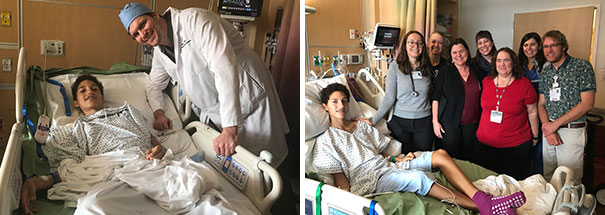“To recover from injuries like those Francesco sustained takes an extraordinary level of not only motivation and resilience, but patience as well,” said his pediatric physical therapist, Jon-Erik Pena, PT, DPT.
A family outing turns tragic
October 28 was supposed to be a fun experience for Francesco, who goes by the nickname Chicco (“Kee-koh”) and his dad, Dr. Filippo Adamo. Father and son took their dog and set out for a kayak excursion on the Marina Lagoon in San Mateo, Calif. Chicco was struck by a motor boat and knocked unconscious.
“I was in shock,” said Adamo. “I just expected that I would see Chicco jump from the water, but he didn’t.” His father swam to him, but Chicco was unresponsive to his father’s voice. Someone had called an ambulance and he was brought to Stanford’s Emergency Department, the only Level 1 pediatric trauma center on the peninsula.
The pediatric trauma team was called to action. Trauma surgeons David Spain, MD and Stephen Shew, MD, led the emergency response to resuscitate Chicco and assess his most urgent needs.
Prioritizing the most critical treatment
“Chicco had large, complex lacerations across his back, chest and head, all deep injuries involving his lungs, spine and the base of brain,” said Shew. The trauma team’s first priorities included life-threatening lung injuries. Trapped air was compressing one lung, hindering Chicco’s breathing and pushing against his heart. Chicco had lost a significant amount of blood, and his blood pressure was dangerously low; required continuous resuscitation with donated blood products. “We had serious concerns for the neurological implications from his head wounds, including possible brain swelling, hemorrhaging and permanent brain injury,” recalled Shew. “Once the immediate life-threatening concerns were addressed, our team of specialists could focus on his other injuries.”
Those specialists numbered in the dozens, including trauma, orthopedic and neurosurgeons, anesthesiologists, critical care physicians and surgical staff.
Chief of pediatric neurosurgery, Gerald Grant, MD, and his team performed the emergent repair of Chicco’s open depressed skull fracture. “I felt like I was back in the military operating theater in Iraq since Chicco’s injuries were so severe,” said Grant. In a patient with multiple traumatic injuries, several teams often need to operate simultaneously to stabilize multiple organ systems and get the patient out of the operating room as soon as possible, Grant said.
Chicco’s injuries included fractures in all the ribs on his left side, several rib fractures on the right and multiple spinal fractures. Furthermore, because Chicco had been submerged in lagoon water, his wounds were at the highest level of infection risk.
“This definitely wasn’t a case you see every day,” said Shew. “But it’s exactly what we are trained for. When every second and every decision can impact the outcome, we have an extraordinary team of experts here who work simultaneously to triage the most critical areas of care.”
Thanks to their collective expertise, the team worked to save his lungs, brain and spine, and treat extensive soft tissue damage and multiple musculoskeletal injuries.
The family, coming to terms
When Adamo arrived in the emergency department, he was struck by the care shown by the staff.
“From the moment I arrived, they offered me dry clothes and the updates from the OR, telling me about the surgeons involved and reassuring me that the environment in the operating room felt calm and under control,” he said. “That was really important to me, just making it possible to wait.”
After about four hours in surgery, Chicco was moved to the pediatric intensive care unit in critical condition. He remained there for one week.
Chicco’s mother, Debra Scott, was traveling out of the country on business when the accident occurred and received the news by phone.
“It’s the phone call that you never want to get as a parent,” said Scott. “It was devastating and very frightening, not knowing if what I was being told by my family over the phone was for my protection, because I was so far away. The not knowing was very difficult. I just got on the first flight I could.”
When Scott saw her son for the first time in the ICU, he was on a ventilator with all sorts of tubing connected to his body. “My knees buckled,” she said. "You just don’t ever think you will see your child in that state.”
Chicco had very limited capacity to communicate, sometimes responding to requests to move his fingers or blink his eyes. “All of this was incredibly concerning and overwhelming,” said Scott. But learning every day from the care teams about Chicco’s care plan helped her to come to terms with what had happened to her son.
A network of care and support
As Chicco’s condition stabilized, his infection risks fell but he continued to require complex multidisciplinary care. Pediatric orthopedic surgeon, John Vorhies, MD, assisted by trauma surgeon Thomas Weiser, MD, performed a six hour operation to stabilize Chicco’s fractures. Chicco’s right arm was fractured and his chest wall had been severely crushed. His multiple rib fractures were impairing his ability to breathe without a ventilator. Dr. Vorhies felt that reconstructing Chicco’s fractured ribs with titanium plates and screws would offer him the best long-term functional outcome by helping him come off the ventilator sooner and easing his pain during recovery. The approach was successful. Soon after the surgery, Chicco was taken off the ventilator, a major milestone in being able to move out of intensive care.

Connect with us:
Download our App: